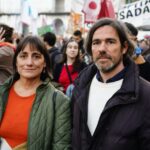
“Look when it’s your turn to speak from the balcony of La Rosada.” When he heard it, she giggled just thinking about it. It was already early in the morning and the talk was taking place in Empire , the traditional pizzeria of Chacarita. A while later the emotion still lasted when they read the first chronicles of the event in the newspapers. It had been a success.
39 years later history repeats itself, although this time that perspective of arrival appears closer. Many things, however, are different. Water has flowed under the bridge and it is no longer “Crazy” Galimberti who tells her, like on that night in 1984, nor does she come from speaking at Luna Park explaining that “the crisis of Peronism is due to having renounced the path of the revolutionary struggle that no one knew how to represent like Evita”, as Ricardo Ragendorfer narrates in his book Patricia. From the armed struggle to Security.
The metamorphosis took time. Between that date and the present, the former JP Patricia Bullrich she navigated through different waters of Peronism that took her successively to the shores of Antonio Cafiero, Carlos Menem or Eduardo Duhalde, but she also made the leap to other latitudes of the political spectrum to be Fernando de la Rúa’s Minister of Labor, from where she left indelible marks. such as reducing by decree 13% of their income to retirees and state workers in the midst of the 2001 crisis. His adventures on the right continued after the outbreak, creating his own label, union for freedom.
A few decades later, today it is another person who whispers in his ear his chances of reaching the balcony of the Casa Rosada. Or, at least, that is assumed. This is what could have happened a few weeks ago in an environment other than the one in which Patricia Bullrich Luro Pueyrredón frequented with her friends from the famous north column of Montoneros, but according to his illustrious family origins, triple last name. With Mauricio Macri he did not meet this January to talk about his presidential project in a busy corner of Buenos Aires, but in the country Cumelénthe exclusive place in Patagonia with araucarias, myrtle trees and a privileged view of Lake Nahuel Huapi where the former president of the PRO made a base this summer to receive leaders and command his electoral assembly projects for 2023. There they are better inspired.
Patricia Bullrich is beginning to be taken more seriously today. Among those who focused on the emergence of Javier Milei as a new phenomenon in Argentine politics and those who believed that Horacio Rodríguez Larreta was the “natural candidate” for Together for Change, less attention has been paid to the persistent work of “la piba”, who He has been traveling the country for a long time in search of his dream.
At least three factors suggest today that she is in a serious race towards the Rivadavia chair and that her project should not be underestimated. On the one hand, different surveys (including one to which he had exclusive access The Left Daily) they give it as a possible winner of the Juntos por el Cambio internship, if Mauricio Macri finally decides not to run -although of course there are also others, since in times of operations there are polls for all tastes. On the other hand, they are symptomatic the movements of some sectors of radicalism that in recent days, sniffing out power, they have begun to show themselves with a high profile together with the president of the PRO and in fact in opposition to the wing of the UCR commanded by Gerardo Morales, the latter closest to the current Head of Government of the CABA. If something was commented on the recent grape harvest festival in Mendoza in the national newspapers, it was not so much the complaint about the living conditions of the workers in the sector, but rather the photo that showed Patricia Bullrich in the center of an image, surrounded by Rodolfo Suárez, Gustavo Valdés, Alfredo Cornejo, Luis Naidenoff, Carolina Losada and Facundo Manes. Finallyand as we discussed in this column last week, the Horacio Rodríguez Larreta’s erratic campaigngoing like a ball without a handle from the center to the right and back to the center, is the clear expression of the crisis of a candidacy that has failed to consolidate a clear profile.
However, we are in Argentina. In the 108 days that remain for the different political spaces to make their candidacies official, many things will happen and the scenario can change, including the elucidation of important factors such as the unknown that the two heavyweights of national politics on both sides of the rift maintain regarding their future. The immediate future of the massista economy, and especially its inflationary factor, will also affect when it comes to getting to the polls.
Anyway, one thing is for sure. The “Bullrich factor” already has an impact on national politics and adds to the “Milei factor” to contribute to an attempt to shift the public debate agenda to the right, which, as we will see, is not the same as the relationship of forces to apply its program , which is more complex. The person who confirmed the first a few days ago was one of the pre-candidates for the presidency of the Frente de Todos, Daniel Scioli, whose pulse did not tremble to say that “I am to the right of the right” on the issue of defending the mobilization of the Armed Forces, other federal forces and intelligence agents to combat drug trafficking. It must be clarified: the ambassador in Brazil, who knew how to share celebrations with Jair Bolsonaro, was running from behind. A few days before, Patricia Bullrich had come out first to mark the militarization agenda. And to think that there are still people who consider that voting for Scioli was an option in 2015 to combat the Macrista right. Anyway.
A few days later it was Alberto Fernández himself who used the national network to take action on the matter and announce the reissue of the failed recipe to send the Armed Forces to Rosario. how they denounced Myriam Bregman y Nicholas del Cañothe measure is not only not a response to the problem, but implies greater social control, not attacking the network of business owners and their accomplices -businessmen, judges, prosecutors, officials, police- and falls almost like a provocation a few days before March 24, a new anniversary of the genocidal coup.
On another plane, the supposed new emerging figure of Kirchner’s progressivism, “Wado” by Pedro, was seen in the last hours being photographed at the opening dinner of the Expoagro exhibition with executives from Clarín and La Nación such as Jorge Rendo (one of the controversial travelers to Lago Escondido), José Aranda and Fernán Saguier. There, the still Minister of the Interior pointed out that “it is necessary to reunite Peronism with the countryside.” If these are the liberals, what will the others be like?
Of course, the “Bullrich factor” does not work alone, but rather works jointly with a communication army at the service of the powerful, which invades the screens and radios with a right-wing discourse that contributes to the creation of fertile ground for the reception of the ideas of whoever was the visible face of the repression in cases such as that of Santiago Maldonado and Rafael Nahuel or the defender of the easy trigger in cases such as that of Luis Chocobar, in his time as minister of Mauricio Macri.
However, It is not possible to separate this scenario from the social background on which it is built, nor should it be interpreted as a consensus to apply the plans of the right. It is one thing to win elections and another to govern, and right-wing demagogy moves in that gray area, based on at least two interrelated elements: the great economic and social crisis that is being experienced, the product of applying the IMF plans and not questioning the capitalist structure of the backward country, and the invaluable collaboration of the Frente de Todos, which vociferates against the right but caused great disappointment in its own base by taking over a large part of its agenda, both in security issues and economic policy or repression of the social protest, as in Guernica or the stigmatization of the protests of the social movements. The demagogy of characters like Javier Milei or Patricia Bullrich cannot be analyzed outside the socioeconomic and political conditions on which they act, nor can the chances that, should one of the variants of the right come to power, return to crash as the project crashed cambiemita when reality reminded them that it was not real that there was a social consensus for their adjustment policies and permanent reformism.
The strong social discontent and the unsatisfied demands accumulated in the last two governments; the hundreds of struggles that -although not widespread- took place in recent years; and the presence of the left on the political scene – betting on growth this year on the disappointment generated by the parties of the regime – are factors to also be taken into account when thinking about the relationship of forces.
The very demagogy that the Frente de Todos will carry out during the electoral campaign against the economic plans of the right, also gives a distorted account of these deepest contradictions, at the same time that it must be fought. At the time of publishing this column, the weekly agenda will begin to change. Cristina Kirchner will focus all her attention on a series of days in which the foundations of the ruling against her for the Highway Cause will be known, then she herself will speak from Viedma on Friday, and on Saturday there will be an act under the slogan “Fight and comes back”. But beyond the vicissitudes of each situation, the speeches and eventual announcements made there, The conclusions of recent years leave no room for doubt: the Kirchnerist policy of promoting candidates like Daniel Scioli and Alberto Fernández, or now of supporting the administration of Sergio Massa, all under the argument of “confronting the right”, has led to the current situation in which not only have the living conditions of millions deteriorated, but the right wing that they were said to fight has preserved itself and may even return to power despite its failures.
Different is the perspective of the left. Looking at the current status of the class struggle in France, a country where the working class is involved in a huge battle against Emmanuel Macron’s pension reform, it can be concluded that sometimes when those at the top become radicalized, those at the bottom emerge. In other words: both Together for Change, Peronism or Javier Milei are preparing to continue and deepen the IMF plans after December 10 of this year if they have to govern. Perhaps they think about it with different rhythms, tactics and different degrees of intention to reach agreements to advance, which, of course, will not be indifferent. But These attempts at greater attacks will only make way for a next government with weaknesses to apply its plans. The enormous activity of agitation, propaganda and organization that the left promotes for this 2023 is inscribed in that strategic thought: to arrive prepared with the greatest possible force from above and below, and the massive installation of a program that responds to the demands of the majorities and question the capitalist domination of the country, for when the relationship of forces is decided, which will be in the class struggle. Any bet on the lesser evil will be nothing more than the reissue of another functional failure of the right and the powerful.
Source: www.laizquierdadiario.com

